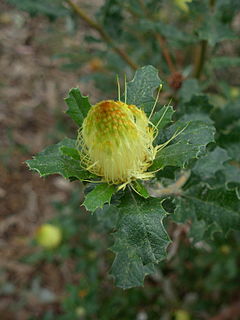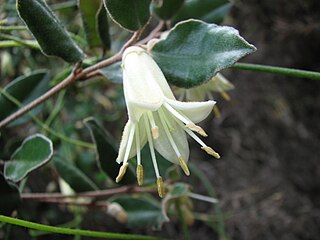
Stylidium is a genus of dicotyledonous plants that belong to the family Stylidiaceae. The genus name Stylidium is derived from the Greek στύλος or stylos, which refers to the distinctive reproductive structure that its flowers possess. Pollination is achieved through the use of the sensitive "trigger", which comprises the male and female reproductive organs fused into a floral column that snaps forward quickly in response to touch, harmlessly covering the insect in pollen. Most of the approximately 300 species are only found in Australia, making it the fifth largest genus in that country. Triggerplants are considered to be protocarnivorous or carnivorous because the glandular trichomes that cover the scape and flower can trap, kill, and digest small insects with protease enzymes produced by the plant. Recent research has raised questions as to the status of protocarnivory within Stylidium.

Stylidium violaceum, the violet triggerplant, is a dicotyledonous plant that belongs to the genus Stylidium. S. violaceum is endemic to Australia and is found primarily in the southwestern region of Western Australia. It can grow up to 50 cm including the scape. The mostly purple flowers are 10 mm tall and 6 mm broad. Leaves are 5 cm long and about 4 mm broad. Flowering occurs mainly from October to January. S. violaceum is found in locations with sandy or loamy sand soil texture conditions on hillslopes, dunes, or winter wet depressions and swamps.

Banksia undata, commonly known as urchin dryandra, is a species of shrub that is endemic to the southwest of Western Australia. It has sessile, wedge-shaped, wavy, serrated leaves, pale yellow flowers in heads of between 80 and 160, and later up to eight follicles in each head.

Banksia tenuis is a species of shrub that is endemic to the southwest of Western Australia. It has pinnatifid, serrated or smooth-edges leaves, golden brown and cream-coloured flowers in heads of about fifty-five and glabrous, egg-shaped follicles.

Stylidium turbinatum is a dicotyledonous plant that belongs to the genus Stylidium. S. turbinatum is endemic to Australia and is found in the northern part of Western Australia in the Kimberley region and near Darwin in the Northern Territory. This species is an erect annual herb that stands 6–15 cm tall. A 2–5 cm long stem bearing scattered leaves terminate in a tuft of 1–2 cm long upper leaves. Several scapes appear from these terminal tufts. The inflorescence is a raceme, which produces pink flowers whose petals are vertically paired. The hypanthium of this species is turbinate and is one of the distinguishing characteristics used to identify it. The sepals form ribs around the hypanthium, giving it a turbine-like appearance. Seeds of S. turbinatum are pale orange and around 0.2 mm long.

Stylidium debile, commonly known as the frail triggerplant, is a carnivorous, dicotyledonous plant that belongs to the genus Stylidium. S. debile is endemic to coastal areas in Queensland and New South Wales, Australia.
Stylidium aceratum is a dicotyledonous plant that belongs to the genus Stylidium. It occurs within the south west region of Western Australia

Stylidium calcaratum, the book triggerplant, is a dicotyledonous plant that belongs to the genus Stylidium. It is an ephemeral annual that grows from 5 to 10 cm tall but can grow larger at 20–30 cm tall in damp forest or scrub habitat. The few ovate leaves produced by this plant form basal rosettes around the stem. The leaves are around 3–5 mm long on short petioles. The scapes are 2–30 cm tall and produce single flowers in smaller plants and up to nine flowers in larger, more robust plants. Flowers are pink or white with red spots or lines at the individual petal bases. The petals are vertically paired and will fold over to meet each other at night or in adverse weather conditions. S. calcaratum is endemic to Australia and has a distribution that ranges from Victoria through South Australia and into Western Australia. Its habitat is recorded as being wet flats or near creeks and seepages. Pollination is achieved by a grey fly, Comptosia cuneata.
Stylidium diceratum is a dicotyledonous plant that belongs to the genus Stylidium. The specific epithet diceratum is Greek for "two horns", referring to the two appendages that are present on the bend of the gynostemium. It is an annual plant that grows from 15 to 35 cm tall. The longer leaves are lanceolate and the shorter ones are spathulate, forming a basal rosettes around the stem. The leaves are around 5–8 mm long and 0.2-2.5 mm wide. Inflorescences are around 6–15 cm long and produce flowers that are orange with dark orange and pink veins and bloom from June to August in their native range. S. diceratum is only known from the type location, which is at creek crossings on the road to Beverley Springs in the Kimberley region of Western Australia. Its habitat is recorded as being sandy soils on creek margins. It grows in the presence of S. ceratophorum, S. rubriscapum, Drosera caduca, D. paradoxa, Byblis liniflora, and Grevillea pteridifolia. S. diceratum is most closely related to S. longicornu, but it can be confused with S. ceratophorum, which also has an orange corolla but twice as large.
Stylidium weeliwolli is a dicotyledonous plant that belongs to the genus Stylidium. It occurs in the North West of Western Australia
Stylidium inaequipetalum, the Ayers Rock triggerplant, is a small herbaceous perennial plant in the genus Stylidium. It grows from 7 to 40 cm tall. Oblanceolate leaves, about 20-100 per plant, form a basal rosette with stems absent. The leaves are generally 15–81 mm long and 2–8 mm wide. This species produces 1-11 scapes per plant. Inflorescences are 7–40 cm long and produce pink flowers with petals all free and blooms almost year-round in their native range. S. inaequipetalum is endemic to the southwestern Northern Territory and Western Australia. Its typical habitat has been reported as sandy soils on sheltered creekbanks or in between rocks. S. inaequipetalum is most closely related to S. floribundum, though it is also closely allied with S. debile.
Stylidium imbricatum, the tile-leaved triggerplant, is a dicotyledonous plant that belongs to the genus Stylidium. It is an herbaceous perennial that grows from 12 to 50 cm tall and has divided stems covered with tile-like leaves that are arranged in a spiral formation around the stem. The ovate-elliptic leaves are basifixed and held closely against the stems. The leaves are around 1.5-1.8 mm long and 0.6-0.8 mm wide. Terminal inflorescences are racemose or spike-like and produce flowers that are reddish violet with laterally-paired lobes and bloom from April to May in their native range. S. imbricatum is only known from south-western Western Australia in Stirling Range National Park and Porongurup National Park south-east to Cheynes Beach. Its habitat is recorded as being sandy or laterite soils in swampy areas, rocky slopes, or heathland. S. imbricatum is distinct within its subgenus because it possesses obovate sepals. Its conservation status has been assessed as secure.
Stylidium preissii, the lizard triggerplant, is a species that belongs to the genus Stylidium. It is an herbaceous perennial that grows from 5–18 cm tall and has divided stems covered with tile-like leaves that are arranged in a spiral formation around the stem. The broadly trullate leaves are basifixed and held closely against the stems. The leaves are around 1.9 mm long and 1.0 mm wide. Inflorescences are umbellate racemes and produce flowers that are white, pale pink, or dark pink and bloom from November to December in their native range. S. preissii is only known from south-western Western Australia from Bremer Bay to Israelite Bay with a few populations near Jandakot. Its habitat is recorded as being white sandy soils in open heathland. S. preissii is distinct within its subgenus because it possesses a strap-like gynostemium column with a dilated cunabulum.

Stylidium perplexum is a species of triggerplant that is endemic to south-west Western Australia. It is a tuberous species that has many stems and has been described as "somewhat shrubby" at 15–40 cm tall. The linear leaves can be 2 cm long and are arranged around the stem in a rosette at the stem apices. The 8–19 cm tall scapes bear 6 to 14 flowers that are white with purple accents and corolla lobes that are laterally paired and 4–6 mm long.

Stylidium affine is a species in the genus Stylidium that is endemic to Western Australia.

Correa backhouseana is a species of rounded shrub that is endemic to coastal and near-coastal areas of southern Australia. It has elliptical to egg-shaped or round leaves that are densely hairy on the lower surface, and cylindrical to funnel-shaped, cream-coloured to pale green or red and yellow flowers.

Eucalyptus rhodantha, commonly known as rose mallee, is a species of straggly mallee or shrub that is endemic to Western Australia. It has smooth bark, a crown composed entirely of heart-shaped, sessile juvenile leaves arranged in opposite pairs, single flower buds in leaf axils, red flowers and pendent, hemispherical to conical fruit.

Acacia ramulosa, commonly known as horse mulga or bowgada wattle, is a shrub belonging to the genus Acacia and the subgenus Juliflorae endemic to arid areas of Australia.

Verticordia huegelii var. decumbens, commonly known as variegated featherflower, is a flowering plant in the myrtle family, Myrtaceae and is endemic to the south-west of Western Australia. It is an almost prostrate shrub, with creamish-lemon coloured flowers turning pink then red as they age, giving the plant a variegated appearance. It is similar to Verticordia huegelii var. huegelii but has a lignotuber and a lower growth habit.
Verticordia huegelii var. tridens, commonly known as variegated featherflower, is a flowering plant in the myrtle family, Myrtaceae and is endemic to the south-west of Western Australia. It is a slender, open, sometimes straggly shrub with bright yellow flowers which age to red and then brown and differently-shaped staminodes from the other varieties of the species.














